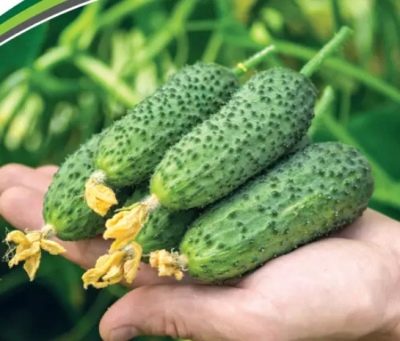
- Authors: Kiramov O.D.
- Year of approval: 2018
- Growth type: indeterminate
- Branching: the average
- Fruit weight, g: 60-70
- Fruit length, cm: 9-12
- Fruit color: dark green
- Cucumber Mosaic Virus Resistance: stable
- Ripening terms: early
- Fruit shape: cylindrical
Hybrid varieties of vegetables and fruit crops are in great demand in specialized stores. Cucumbers are almost in the first position among the existing selection achievements. Estet is one of the highly productive hybrids.
Description of the variety
The first generation parthenocarpic hybrid was created for growing in film, glazed and polycarbonate greenhouses, temporary greenhouses and open ground.
Peculiarities:
yield;
unpretentiousness;
stress tolerance;
keeping quality and good taste;
duration of transportation;
fruits do not tend to overgrow;
attractive appearance and excellent germination.
The disadvantages are the rather high cost of the hybrid and the inability to independently procure the seed material. To do this, the company crosses certain varieties, which ones, it is impossible to say, since any seed company keeps such information secret.
Characteristics of the appearance of plants and zelents
Indeterminate hybrid Estet, not prone to too much branching, is able to grow shoots up to two meters long and more. Gardeners have to limit its growth in order to get a higher yield and not allow the plant to waste its energy on excessive vegetation. A well-developed root system gives a powerful central shoot with pronounced edges and an average number of lateral shoots.
The stem is covered with abundant foliage of rich green tones of the traditional type of medium size, has medium-sized internodes. Each leaf is attached to the stem with a long petiole. Predominantly female flowering gives many (3 or more) ovaries, collected in one bunch.
Cylindrical zelents have a rich dark green color and a lumpy surface. The tubercles are located rather close to each other and have small spines. The small seed chamber is filled with underdeveloped seeds, completely devoid of germination ability. The size of gherkins: length from 9 to 12 cm, diameter 2.2 cm, weight confidently keeps in the region of 60-70 grams, rarely reaching large values.
Purpose and taste of fruits
Aligned and beautiful fresh fruits are able to decorate the table in slices and in whole. They are good in light-salted form and in salads, they look perfect in cans for whole-fruit canning, despite the fact that they belong to the salad category. Delicate, juicy, dense pulp has a balanced sweetish taste with a pronounced refreshing effect and pleasant aroma.
Maturation
Esthete refers to early ripening hybrids - 38-40 days pass from the appearance of the first shoots to the beginning of fruiting. Indicators may vary in one direction or another, depending on the growing conditions and climatic characteristics of the region.
Yield
The hybrid has a good yield and is capable of producing an average of 14.3 kilograms per square meter.
Landing scheme
The optimal planting of a hybrid is 4 roots per square meter.
Growing and care
The hybrid is grown by seedling and direct sowing into the ground. In both cases, the timing of sowing seeds is different.
Seeds for seedlings are sown in March, if these are the southern regions, and in May (beginning and middle of the month) if we are talking about cold areas.
In open ground, seeds are sown in April in the south and in late May - early June in the Urals and Siberia.
Much also depends on the conditions in which Estet will be grown. For greenhouses, these dates come much earlier than for a vegetable garden.
Hybrid care consists of traditional activities such as watering and feeding, loosening, hilling and weeding, as well as forming and tying long shoots. Vertical cultivation provides good ventilation and fresh air access. The horizontal arrangement of the lashes can lead to the appearance of fungal diseases, decay of roots and fruits.
It is recommended to tie each stem, taking into account the permissible height at which it will be comfortable to work with the crop and harvest. Usually, the shoots themselves rise along the support, but with a heavy load and length, they may refuse to rise higher than 1-1.5 meters. In this case, you should help them forcibly, simply by curling the top around the twine. Feeding with nitrogen and potassium-phosphorus preparations is carried out 2 times a month.
Soil requirements
Aesthete, despite its adaptive abilities and undemanding agrotechnics, will require good illumination and protection from cold winds and constant drafts. The soil should be light and breathable, with a good level of fertility, saturation with minerals and trace elements.

In order to collect strong, tasty and beautiful cucumbers on your site, you need to make top dressing. Lack of nutrients can negatively affect the appearance of the plant and significantly reduce the yield. Fertilize cucumbers with organic fertilizers in combination with mineral fertilizers. With the right balance of these components and adherence to the fertilizing schedule, the cucumber yield will be maximum.
Required climatic conditions
The cucumber is quite resistant to unfavorable weather conditions, such as sudden cold snaps, drought and heat.
Disease and pest resistance
The plant is resistant to cucumber mosaic virus, cladosporium disease (brown olive spot), powdery mildew.

Despite their popularity, cucumbers are often attacked by diseases and pests. From them, cucumber plantings often die before the start of fruiting. In order to prevent this from happening, it is necessary to try to prevent ailments or get rid of them at the very beginning, having studied in detail their causes of occurrence, signs and methods of treatment.





























































































